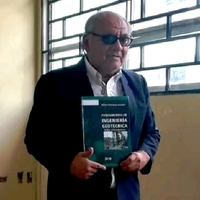Papers by Nishant Sachdeva
Indian geotechnical journal, Feb 20, 2024

Evergreen, Nov 30, 2023
Expansive soils usually face problems related to excessive expansion and contraction, high water ... more Expansive soils usually face problems related to excessive expansion and contraction, high water retaining capacity, poor drainage, high compressibility and poor load transfer mechanism. The rate of failures in these soils is relatively high and these soils are considered as most vulnerable for construction purposes. The amendment of using waste materials in soil stabilization serves the purpose of limiting the high volume of waste generated from different sources. This in turn also restricts the consumption of natural resources which are conventionally used to stabilize the soil. Out of several waste materials generated from various sectors: agricultural, industrial, construction and demolition and mining, twenty-one highly generated but underutilized waste materials have been designated for review in this study. Their utilization as additives in soil stabilization as a partial or full replacement of conventional/traditional additives has been appraised in the present study. Among the various agricultural waste products considered, palm oil fuel ash (POFA) has been found to be the most effective with the optimum dose of 10 % -30 % in soil stabilization. Cement kiln dust (CKD) and iron ore tailings (IOT) with 50 % lime were found out to be effective with the optimum dosage of 20 % and 16 %, respectively. C&D waste was applicable in the range of 10 % -24 % in the presented research work owing to the variable characteristics of the source. This paper would be helpful to industry persons in adopting alternative additives and researchers in knowing the areas which require further research.

SKIT Research Journal
Warm Mix Asphalt (WMA) is widely utilized in many parts of the globe due to its ability to combin... more Warm Mix Asphalt (WMA) is widely utilized in many parts of the globe due to its ability to combine the benefits of both hot mix and cold mix. Solidification is enhanced at lower temperatures when the adhesive's viscosity is decreased. On addition of additive, the asphalt mix is able to attain the properties of hot mix at the mixing temperature of a cold mix. To make the asphalt layer less vulnerable to low temperatures and have excellent permanent deformation qualities, the organic additives must be selected in such a manner that they melt at a lower temperature than predicted for the asphalt layer to reach the development site. Blends with the right qualities may be made in a more cost and environmentally-friendly way by using WMA expertise in asphalt. In recent years, there has been a rise in awareness of environmental and health risks in the construction industry. Various methods and additives have been developed by the industry to reduce the required assembly temperature of asphalt mixes, and this has resulted in the development of a new blend type known as Warm-mix-Asphalt (WMA). In this paper a review of contemporary practices of use of Sasobit in preparation of Warm mixes has been done.
Materials Today: Proceedings
Materials Today: Proceedings
3RD INTERNATIONAL CONFERENCE OF BIO-BASED ECONOMY FOR APPLICATION AND UTILITY
Materials Today: Proceedings

SKIT Research Journal
Waste is defined as material by-products of any kind that have no residual value from human or in... more Waste is defined as material by-products of any kind that have no residual value from human or industrial activities. Elimination of brick dust landfills is a serious and important task that is being considered by many countries around the world. The reuse of brick dust for road construction is a sustainable solution to ecological problems. The reuse of brick dust reduces road construction and landfill costs. The purpose of this study was to examine the overall performance of a bituminous concrete mix in which brick dust replaced certain combinations of specific aggregates in different proportions. In this study, brick dust was used in proportions of 5%, 10%, and 15% as a substitute for natural sand. The optimum range of substitution was determined based on results obtained from Marshall Parameters. In general, studies have shown that the use of brick dust in bituminous Concrete mixes is acceptable.
SKIT Research Journal, 2021
The development of Public Transportation Infrastructure needs utmost attention to solve the issue... more The development of Public Transportation Infrastructure needs utmost attention to solve the issues related to congestion, accidents, and pollution. Bus Rapid Transit System (BRTS) has turned out to be one the effective and safe mode. For smooth functioning of the same, all the infrastructure elements linked to the corridor must also be designed accordingly. The current study focuses on redesign of an intersection of BRT Phase-II corridor in Jaipur city. The deficiency in the existing design related to geometrics, traffic control features etc. were examined. The redesign of the selected intersection has been presented showcasing the safety gains.
International Journal for Research in Applied Science and Engineering Technology, 2018
On the basis of this study it has been concluded that if the compaction temperature falls below 1... more On the basis of this study it has been concluded that if the compaction temperature falls below 110˚C, durability parameters of the mix deteriorate drastically.
SKIT Research Journal, 2021
In today's scenario, availability of natural aggregates is diminishing and simultaneously the was... more In today's scenario, availability of natural aggregates is diminishing and simultaneously the waste generation due to debris of demolished buildings is increasing considerably. Incorporationg these demolished materials into construction process can provide a respite from both these issues. The aggregate from demolished structures mainly consists of 70-80% of concrete components as per different studies, so it will be very beneficial for the environment to recycle this aggregate for construction works. In this paper a review of contemporary practices of use of recycled concrete aggregate in pavement construction has been done.











Uploads
Papers by Nishant Sachdeva